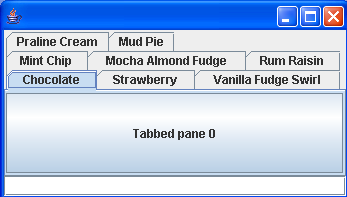Demonstrates the Tabbed Pane

// : c14:TabbedPane1.java
// Demonstrates the Tabbed Pane.
// <applet code=TabbedPane1 width=350 height=200></applet>
// From 'Thinking in Java, 3rd ed.' (c) Bruce Eckel 2002
// www.BruceEckel.com. See copyright notice in CopyRight.txt.
import java.awt.BorderLayout;
import java.awt.Container;
import javax.swing.JApplet;
import javax.swing.JButton;
import javax.swing.JFrame;
import javax.swing.JTabbedPane;
import javax.swing.JTextField;
import javax.swing.event.ChangeEvent;
import javax.swing.event.ChangeListener;
public class TabbedPane1 extends JApplet {
private String[] flavors = { "Chocolate", "Strawberry",
"Vanilla Fudge Swirl", "Mint Chip", "Mocha Almond Fudge",
"Rum Raisin", "Praline Cream", "Mud Pie" };
private JTabbedPane tabs = new JTabbedPane();
private JTextField txt = new JTextField(20);
public void init() {
for (int i = 0; i < flavors.length; i++)
tabs.addTab(flavors[i], new JButton("Tabbed pane " + i));
tabs.addChangeListener(new ChangeListener() {
public void stateChanged(ChangeEvent e) {
txt.setText("Tab selected: " + tabs.getSelectedIndex());
}
});
Container cp = getContentPane();
cp.add(BorderLayout.SOUTH, txt);
cp.add(tabs);
}
public static void main(String[] args) {
run(new TabbedPane1(), 350, 200);
}
public static void run(JApplet applet, int width, int height) {
JFrame frame = new JFrame();
frame.setDefaultCloseOperation(JFrame.EXIT_ON_CLOSE);
frame.getContentPane().add(applet);
frame.setSize(width, height);
applet.init();
applet.start();
frame.setVisible(true);
}
} ///:~
Related examples in the same category